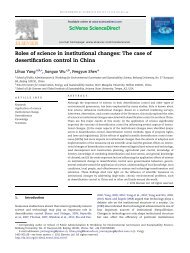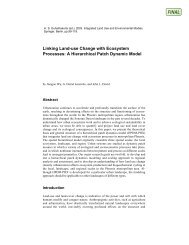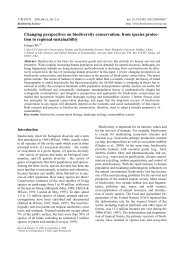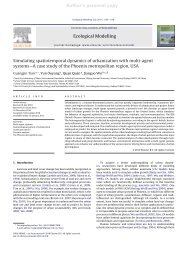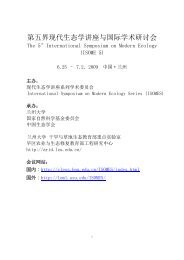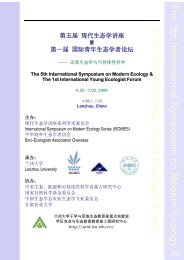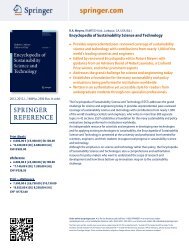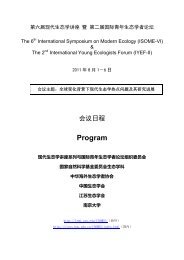Wu, J. and J. L. Vankat. 1995. Island biogeography: theory and ...
Wu, J. and J. L. Vankat. 1995. Island biogeography: theory and ...
Wu, J. and J. L. Vankat. 1995. Island biogeography: theory and ...
Create successful ePaper yourself
Turn your PDF publications into a flip-book with our unique Google optimized e-Paper software.
Jianguo <strong>Wu</strong> <strong>and</strong> John L. <strong>Vankat</strong> Isl<strong>and</strong> Biogeography: Theory <strong>and</strong> Applications<br />
develop non-equilibrium theories of isl<strong>and</strong><br />
<strong>biogeography</strong> which emphasize the importance<br />
of such characteristics of isl<strong>and</strong> biotas as habitat<br />
heterogeneity <strong>and</strong> transient (non-equilibrium)<br />
dynamics.<br />
VI. Concluding Remarks<br />
The MacArthur <strong>and</strong> Wilson’s dynamic<br />
equilibrium <strong>theory</strong> has had revolutionary impact<br />
on isl<strong>and</strong> <strong>biogeography</strong> in particular <strong>and</strong> on<br />
<strong>biogeography</strong> in general by providing a<br />
conceptual framework <strong>and</strong> insight into the<br />
dynamics of geographical patterns of species<br />
diversity. It has been one of the more influential<br />
concepts in <strong>biogeography</strong>, ecology, <strong>and</strong><br />
evolutionary biology. However, several aspects<br />
of the equilibrium <strong>theory</strong> remain unsubstantiated,<br />
<strong>and</strong>, while it appears to hold in some specific<br />
cases, it does not in many others. Uncritical<br />
application of the <strong>theory</strong> to nature conservation<br />
is unwarranted <strong>and</strong> may lead to misleading<br />
conclusions.<br />
In general, as with other equilibrium<br />
paradigms in ecology, the equilibrium <strong>theory</strong> of<br />
isl<strong>and</strong> <strong>biogeography</strong> is being treated with<br />
increasing skepticism. Nevertheless, the criticism<br />
does not completely negate the value of the<br />
<strong>theory</strong> of isl<strong>and</strong> <strong>biogeography</strong>. Qualitative use of<br />
the <strong>theory</strong> can result in valuable contributions to<br />
studies even when its quantitative application<br />
may be invalid. More specifically, the <strong>theory</strong> was<br />
<strong>and</strong> still is important in guiding scientists in<br />
constructing conceptual frameworks for<br />
addressing relevant questions in which patchiness<br />
<strong>and</strong> isolation otherwise may not have been<br />
sufficiently emphasized or even identified. In<br />
fact, as indicated in the preface of their book,<br />
even MacArthur <strong>and</strong> Wilson did not believe that<br />
the equilibrium model would exactly fit all field<br />
observations; instead, they hoped that the <strong>theory</strong><br />
would provide stimulus <strong>and</strong> impetus for<br />
advancing “new forms of theoretical <strong>and</strong><br />
empirical studies.” In this regard, the equilibrium<br />
<strong>theory</strong> of isl<strong>and</strong> <strong>biogeography</strong> is one of the most<br />
successful theoretical developments in the<br />
history of <strong>biogeography</strong> <strong>and</strong> ecological science.<br />
Glossary<br />
Area effect The phenomenon that species<br />
extinction rate is reduced with increasing isl<strong>and</strong><br />
area.<br />
Distance effect The phenomenon that species<br />
immigration rate is reduced with increasing<br />
distance between an isl<strong>and</strong> <strong>and</strong> its continental<br />
source of colonizing species.<br />
Extinction curve The curve relating species<br />
extinction rate to the number of species already<br />
present on an isl<strong>and</strong>.<br />
Immigration curve The curve relating species<br />
immigration rate to the number of species<br />
already present on an isl<strong>and</strong>.<br />
Encyclopedia of Environmental Biology. Vol. 2. Page 378<br />
Isl<strong>and</strong> <strong>biogeography</strong> The study of pattern in<br />
the distribution of species on isl<strong>and</strong>s as<br />
influenced by ecological <strong>and</strong> evolutionary<br />
processes related to isl<strong>and</strong> characteristics such as<br />
isolation <strong>and</strong> area.<br />
Rescue effect The phenomenon that species<br />
extinction rate is reduced when immigration of<br />
conspecific individuals provides demographic<br />
reinforcement <strong>and</strong> augments genetic variability<br />
of existing populations.<br />
Species-area curve The curve relating number<br />
of species to isl<strong>and</strong> area.<br />
Species diversity Either the absolute number<br />
of species (species richness), or a measure that<br />
incorporates both the number of species <strong>and</strong><br />
their relative abundance.<br />
Species turnover Changes in species<br />
composition resulting from concurrent<br />
extinction of existing species <strong>and</strong> replacement by<br />
immigration of new species.<br />
Target effect The phenomenon that species<br />
immigration rate increases with increasing area of<br />
isl<strong>and</strong>s, when distance is constant.<br />
Bibliography<br />
Begon, M., Harper, J. L., <strong>and</strong> Townsend, C. R.<br />
(1990). “Ecology: Individuals, Populations,




